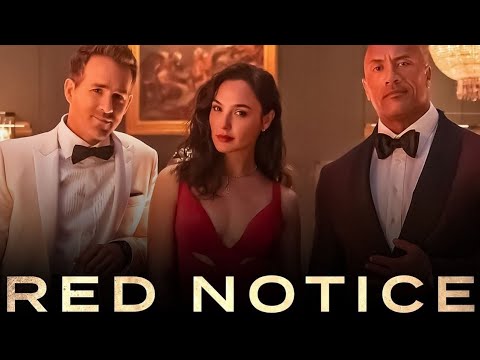Introduction:
Red Notice arrives not just as a film, but as a cultural product engineered for the age of algorithmic entertainment. Written and directed by Rawson Marshall Thurber, and featuring three of the most bankable stars in modern cinema—Dwayne Johnson, Gal Gadot, and Ryan Reynolds—it combines action, comedy, and heist tropes into a singular concoction designed for global consumption.
At first glance, Red Notice may seem like a high-budget romp filled with international chases, extravagant set pieces, and quick-witted banter. But beneath the gloss of its fast-paced thrills lies a deeper structure—one that reflects how modern narratives are constructed, consumed, and manipulated in a world driven by spectacle over substance.
The film borrows liberally from classic heist and buddy cop formulas, but reconfigures them into a stylized, postmodern heist caper, where allegiance is temporary, identity is fluid, and trust is a currency as volatile as cryptocurrency.
Narrative Summary and Construction:
The plot centers around the pursuit of three ancient, jewel-encrusted eggs once gifted to Cleopatra. The eggs—MacGuffins by design—serve less as narrative anchors and more as glowing orbs of plot propulsion, moving the characters from one exotic location to another.
Dwayne Johnson plays FBI profiler John Hartley, who finds himself entangled in a web of deception after being framed for stealing one of the eggs. Ryan Reynolds is Nolan Booth, a sarcastic, master art thief who claims to be the world’s best—though this title is hotly contested by Gal Gadot’s character, the enigmatic and ruthless Bishop. As the story unfolds, Hartley and Booth are forced into a reluctant partnership, while Bishop manipulates events from the shadows, always one step ahead.
The film is structured around a series of double-crosses, sudden reveals, and unexpected alliances—culminating in a twist that recontextualizes the entire film.
Visual Language and Aesthetic Construction:
Red Notice wears its blockbuster DNA on its sleeve. The cinematography favors vibrant lighting, smooth crane shots, and glossy set pieces. From the Vatican to Russian prison camps, bullfighting arenas to jungle ruins, each location is presented as a postcard-perfect backdrop—never meant to reflect reality, but to emulate the aesthetic of high-stakes adventure gaming and escapist fantasy.
The color palette is clean and digital. Shadows are minimal. Everything feels curated and deliberate. The film’s visual smoothness echoes its thematic underpinning: in a world of heists and cons, appearances matter more than truths.
Interestingly, the camera never lingers on any scene long enough for atmosphere to build. The editing is rapid, kinetic. This choice serves the genre’s demands but also highlights the fleeting nature of trust and permanence in the story. Locations change. Allegiances shift. The only constant is motion.
Character Dynamics: The Art of Mask-Wearing
1. John Hartley (Dwayne Johnson): The Performance of Authority
At first presented as an FBI profiler, Hartley is the physical embodiment of law and order. He’s stoic, calculated, physically dominant, and driven by a supposed moral code. But as the narrative progresses, the cracks in this image appear—especially once he is imprisoned and forced into collaboration with Booth.
What’s compelling about Hartley is how he operates as a vessel of deception. He plays the “straight man” in a comedic duo, but the film hints that he’s more than meets the eye. His morality is performative, and by the end, we learn it was part of a long con. He’s not just part of the system—he’s gaming it.
Hartley reflects how institutions (like the FBI) can be impersonated convincingly when enough charm, muscle, and confidence are applied. He is a construct—emphasizing that the line between criminal and lawman is not just blurry, but narratively interchangeable.
2. Nolan Booth (Ryan Reynolds): The Meta-Trickster
Booth is the film’s most self-aware character. He doesn’t just crack jokes—he breaks the fourth wall of genre expectation. He knows he’s in a heist movie. He comments on tropes, subverts seriousness, and mocks every dramatic moment with deflection.
Yet, beneath the sarcasm is a wounded ego. Booth wants to be recognized—not just as a thief, but as the best. His humor shields insecurity. His trust in Hartley, though seemingly flippant, evolves into a form of emotional vulnerability. He becomes the heart of the film—not because of moral depth, but because he represents the audience’s own cynicism and craving for entertainment.
Booth is not loyal to people, but to the game. And yet, his eventual betrayal is not bitter—it is playful. This is his nature. He’s not evil, just adaptive. A trickster in the oldest mythological sense.
3. The Bishop (Gal Gadot): Feminine Power and Moral Ambiguity
Gal Gadot’s Bishop is poised, calculated, and consistently dominant. Unlike the two men, who bicker and stumble, she moves with surgical precision. Her beauty is weaponized; her intelligence never in question. She controls the narrative even when off-screen.
What makes Bishop so captivating is her embodiment of the feminine as strategic power. She is never a damsel, never reactionary. She orchestrates events, seduces when needed, attacks when threatened, and most importantly—wins.
The reveal that she and Hartley are romantic and criminal partners reframes the entire film. Every beat was part of her chessboard. She is the only character with complete narrative control.
Themes:
1. Trust as Currency
Trust in Red Notice is transactional. Characters constantly ally, betray, and realign. There’s a rhythm to it—like the shuffle of a card deck. What is most fascinating is how the film doesn’t condemn deceit—it celebrates it. Intelligence in this world is measured by one’s ability to lie convincingly.
Trust is not rooted in morality but in mutual benefit. Hartley and Booth trust each other just enough to escape danger—but not enough to share motives. Bishop trusts no one, but manipulates everyone. Even the audience is tricked, believing in false alliances and fabricated identities until the final twist.
In this universe, deception is not failure—it’s style.
2. The Illusion of Identity
Red Notice questions identity through performance. Hartley pretends to be an FBI agent. Booth pretends to be a criminal with a heart. Bishop pretends to be alone in her quest. Everyone wears masks. Even the film wears one—posing as a popcorn flick while layering in satire about systems of power.
Who are these people, really? Are they their titles? Their actions? Their loyalties?
The answer the film suggests is: it doesn’t matter. Identity is malleable. What matters is who can control the illusion longer.
3. The Commodification of Art and History
The eggs of Cleopatra represent not just historical artifacts, but the objectification of value. They are priceless because they are rare, because they are desired. Yet no one in the film cares about their history. They are props—symbols of wealth and power to be stolen, flaunted, and traded.
The heist isn’t about reclaiming history—it’s about possession. Art becomes commerce. History becomes a playground. This mirrors how, in the real world, cultural artifacts are often removed from context and turned into trophies for the elite.
Tone and Genre Manipulation
Red Notice is a heist film, a buddy comedy, an action thriller—and a parody of all three. It shifts tone rapidly: from emotional bonding scenes to high-octane chases, from prison brawls to tango dances. These tonal shifts are intentional, highlighting the film’s awareness of its own artifice.
It never asks to be taken too seriously. And yet, it never becomes farce. That balance is delicate, and it’s sustained by the charisma of its leads. Each one brings a different flavor—Reynolds brings irreverence, Johnson brings grounded charm, and Gadot brings icy finesse. Together, they create a tonal triangle that holds the film together even when the plot stretches credibility.
The Ending: Control and Continuation
The final twist—that Hartley and Bishop were partners all along, and Booth has been played—redefines everything. It’s not just a surprise for the sake of surprise. It’s a commentary on control. Who writes the story? Who holds the pen?
In a clever reversal, Booth joins their partnership, setting up a trio dynamic for potential sequels. The hunter, the hunted, and the mischief-maker become equals. But this equality is fragile. In a world built on deceit, friendship is conditional.
The film ends not with resolution, but with the promise of more game-playing, more heists, and more betrayal. It’s a cinematic ouroboros—constantly devouring and reinventing itself.
Conclusion: The Heist of the Audience’s Expectations
Red Notice is not trying to be The Godfather or Inception. It doesn’t seek to interrogate human nature or craft profound existential metaphors. What it does aim for—and succeeds at—is to entertain, mislead, and subvert genre expectations with style.
It reflects the digital age’s obsession with identity fluidity, spectacle, and mythologized criminality. The film is less about stealing eggs and more about stealing attention—through charisma, manipulation, and narrative agility.
In that sense, Red Notice is the ultimate modern con: it invites you to believe one thing, then flips the table. But rather than feel cheated, you’re amused—because the game was the point all along.
The real red notice isn’t just a plot device—it’s a signal to the audience: nothing is real, everything is for show, and the biggest thrill is not the heist—it’s realizing you’ve been played.

